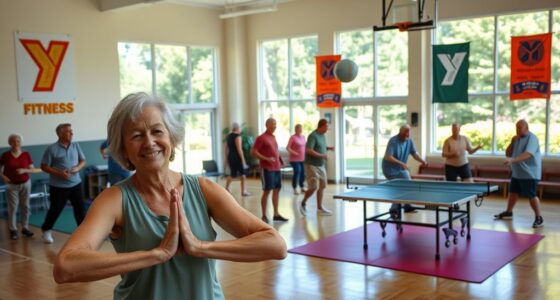Resistance band workouts are perfect for you as a senior looking to build strength safely. They help improve flexibility and overall fitness without straining your joints. Start with light resistance to focus on form, and gradually increase as you gain strength. With various exercises targeting different muscle groups, these workouts enhance daily functional fitness and support independence. Keep exploring to discover the wide range of benefits and routines specifically designed for you.
Key Takeaways
- Resistance band workouts are low-impact, making them ideal for seniors to maintain strength and flexibility without stressing joints.
- Start with light to medium resistance bands to focus on proper form and gradually increase tension as strength improves.
- Effective exercises for seniors include arm presses, leg extensions, and seated twists, promoting overall functional fitness.
- Always consult a healthcare provider before beginning workouts to ensure safety and address any pre-existing conditions.
- Utilize online resources, such as videos and communities, for guidance and motivation in resistance band training.
Importance of Resistance Band Workouts for Seniors

As you age, maintaining strength and flexibility becomes essential for your overall well-being, and resistance band workouts can play an important role in that. These exercises are endorsed by public health guidelines, offering low-impact options that help restore physical well-being in seniors. By engaging in resistance band exercises, you can combat age-related muscle loss, which is vital for preserving your functional independence. Additionally, regular physical activity can provide cognitive benefits that support mental health in older adults. Furthermore, studies show that developing strong family bonds through shared activities can enhance your motivation to stay active. Moreover, engaging in regular physical activity can enhance your cardiovascular health, contributing to overall wellness.
These workouts enhance both strength training and flexibility, making them safer and more accessible as you experience changes in muscle strength. Research indicates that tailoring resistance band exercises to your fitness level allows you to improve your quality of life, better support daily activities, and reduce the risk of falls, promoting long-term health benefits. Additionally, incorporating financial considerations for elderly care can further support your ability to engage in regular exercise and maintain your health. Seeking professional help can also provide guidance on safe exercise practices for seniors.
Precautions Before Starting
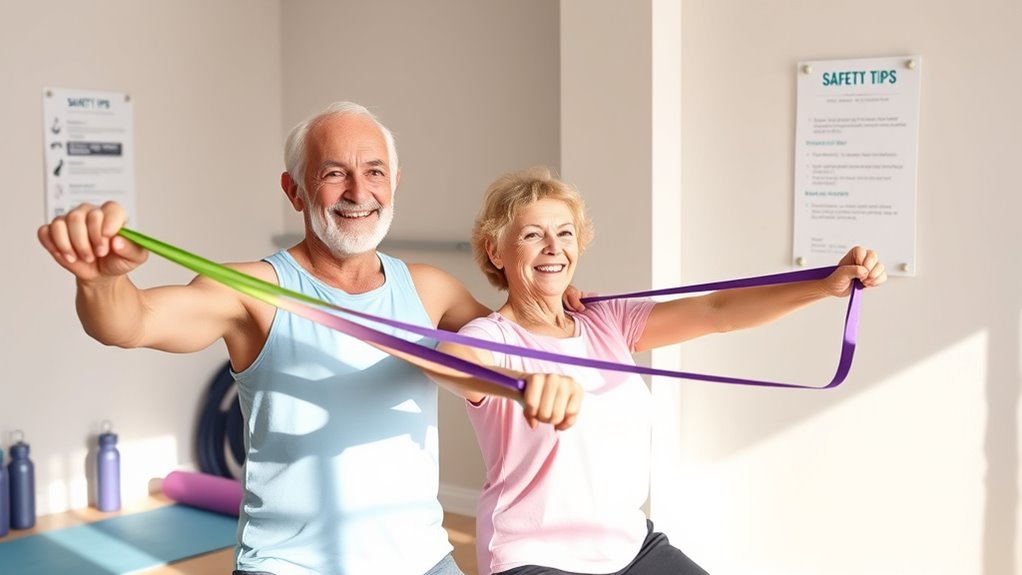
Before starting resistance band workouts, you should consult your healthcare provider, especially if you have any pre-existing conditions.
A light warm-up, like brisk walking, is essential to prepare your muscles and lower the risk of injury. Additionally, understanding risk management strategies can help ensure that your workouts are effective and safe. Incorporating stress management techniques can enhance your overall workout experience and promote better recovery. Remember that regular physical activity is vital for improving overall health and well-being as you age. Engaging in high vibrational energy can also positively impact your workout routine and overall fitness journey. Furthermore, maintaining a balanced budget for fitness-related expenses can help you invest in quality equipment and classes.
Additionally, start slow and steady, focusing on controlled movements to safely build your strength.
Consult Healthcare Provider First
Consulting a healthcare provider is vital for seniors considering resistance band workouts, especially if there are pre-existing injuries or health conditions involved.
Your healthcare provider can help identify any specific concerns or limitations that should be addressed in your exercise program. This tailored approach guarantees that your workouts are safe and effective, allowing you to build strength without risking injury. Additionally, early detection of breast cancer symptoms is crucial for overall health, particularly for seniors who may be at higher risk. For mammography guidelines, it’s important to discuss your screening options during your consultations. Engaging in regular exercise can also support emotional well-being, which is essential for seniors as they navigate various life changes. Regular physical activity can help foster resilience in facing life’s challenges and contributes significantly to overall mental health.
Starting slowly with light resistance bands and focusing on controlled movements is important. Moreover, engaging in regular exercise has been shown to help improve mental health in seniors. Additionally, regular check-ins with your healthcare professional can help adapt your exercise program as your fitness levels progress.
Warm-Up Exercises Essential
How can you guarantee your muscles are ready for resistance band workouts? Start with light warmup exercises like brisk walking or gentle stretching to prepare your muscles and reduce the risk of injury. These activities increase blood flow, enhance flexibility, and improve overall performance. Engaging in these warm-up exercises can also promote quality sleep, which is essential for recovery and optimal health. Additionally, creating a calm environment can further enhance your focus and readiness for the workout. Focus on controlled movements to safely activate the muscle groups and joints needed for resistance training. Incorporate dynamic stretches into your routine to boost your range of motion. Additionally, understanding the critical periods for physical activity can help optimize your workout routine. Regular physical activity can also support the maintenance of required minimum distributions (RMDs) for those managing retirement funds. Using gentle stretching techniques can also help prevent muscle strain during your resistance band workouts.
| Warm-Up Exercise | Purpose |
|---|---|
| Brisk Walking | Increases heart rate |
| Arm Circles | Loosens shoulder joints |
| Leg Swings | Enhances hip flexibility |
| Gentle Stretching | Prepares muscles for action |
| Controlled Movements | assures safety and effectiveness |
Consult a healthcare provider if needed.
Start Slow and Steady
Starting a new resistance band workout can be exciting, but it’s essential to ease into it to prevent injury. Always consult your healthcare provider, especially if you have pre-existing injuries or health conditions.
Begin with light warm-up exercises, like brisk walking, to prepare your muscles and reduce the risk of injury. As you start slow and steady, focus on maintaining good form with controlled movements. Additionally, consider creating an advance directive to ensure your health care preferences are honored during your fitness journey. Engaging in nighttime meditation can also help improve your relaxation and overall mental clarity, which is beneficial for your workout routine. It’s also crucial to establish clear rules for children regarding physical activities to promote a safe environment for everyone involved.
Using a light resistance band at first allows you to challenge your muscles without strain. Gradually increase the resistance as your strength improves.
Identify any specific concerns before starting, so you can tailor your workout program effectively, prioritizing both safety and effectiveness for your fitness journey. Additionally, consider seeking professional help if you find it challenging to manage work-life balance, as it can impact your overall well-being and fitness routine.
Choosing the Right Resistance Band

When choosing a resistance band, it’s crucial to understand the different resistance levels available and how they can suit your fitness needs.
You’ll also want to take into account the types of bands, like loop bands or those with handles, which can enhance your grip and ease of use.
Selecting the right band guarantees you can safely progress in your workouts while maintaining comfort.
Resistance Levels Explained
Choosing the right resistance band is vital for maximizing your workout while minimizing the risk of injury. Resistance bands come in various colors that usually indicate different resistance levels, though this can vary by brand.
For seniors, light to medium resistance bands are typically recommended, as they help prevent excessive strain on muscles and joints. Start with a light resistance band to focus on proper form and control; this foundation will be imperative as you gradually increase resistance.
Bands with handles can improve your grip and ease of use, allowing for a greater range of motion. Always verify the band allows for full movement while providing enough tension to engage your muscles effectively during workouts.
Band Types Available
With a solid understanding of resistance levels, it’s important to explore the types of resistance bands available. There are several options to choose from, including long elastic bands, loop bands, and bands with handles. Each type caters to different exercise needs and preferences.
For example, mini bands are great for lower body workouts, as you can loop them around your thighs or ankles to boost resistance in squats and lateral movements. Superbands offer versatility and can be anchored to doors or stable surfaces, perfect for home workouts.
Importance of Handles
Using resistance bands with handles can greatly enhance your workout experience. The improved grip from handles gives you better control during exercises, helping you maintain proper form and reducing the risk of injury.
This is especially important for seniors, as it allows for a greater range of motion and easier execution of various resistance band exercises. Many bands with handles come in light to medium resistance levels, making them ideal for those new to strength training.
Additionally, ergonomic handles alleviate discomfort in your hands and wrists, guaranteeing your workouts remain enjoyable. By choosing bands with durable handles, you secure longevity and consistent performance, allowing you to effectively incorporate resistance training into your fitness routine.
Resistance Band Exercises Overview

Resistance band exercises offer a versatile and effective way for seniors to enhance their strength and flexibility from the comfort of home.
Resistance band exercises provide seniors with a practical solution to improve strength and flexibility right at home.
These resistance band workouts can be easily adapted to fit various fitness levels, making them perfect for maintaining muscle mass and overall fitness. Common exercises include the Leg Press, Calf Press, Bent Over Row, Glute Bridges, and Chest Pull, each targeting different muscle groups.
You can perform these exercises in seated or standing positions, accommodating your mobility preferences. Aim for 8 to 15 repetitions for each exercise, focusing on controlled movements to build strength safely.
Incorporating an exercise band into your routine can greatly improve your joint mobility and overall quality of life.
Benefits of Resistance Band Exercises

Resistance band exercises offer a low-impact way to strengthen your muscles without putting stress on your joints.
You’ll find that these workouts enhance your functional fitness, making daily tasks easier and boosting your overall quality of life.
Plus, their versatility allows you to target different muscle groups, regardless of your fitness level.
Low Impact Training
While many seniors worry about the strain traditional workouts can place on their joints, low-impact resistance band exercises offer a safe and effective alternative.
These band exercises help in several ways:
- Reduced Stress: They considerably lower stress on your joints, minimizing injury risks.
- Muscle Engagement: They target multiple muscle groups, enhancing overall strength and functionality.
- Adjustable Resistance: Bands allow you to gradually increase resistance, reducing the risk of overexertion.
- Improved Balance: Regular use can boost flexibility, coordination, and balance, essential for preventing falls.
Improved Functional Fitness
Improving your functional fitness is essential for maintaining independence as you age, and resistance band exercises play an important role in this process. By targeting key muscle groups, resistance bands help you build strength for daily activities like walking, climbing stairs, and lifting objects.
These low-impact workouts reduce stress on your joints while effectively combating age-related strength loss. Research shows that engaging in resistance training can greatly enhance your balance and mobility, lowering your risk of falls.
Additionally, resistance bands allow for a variety of movements that mimic everyday tasks, promoting better coordination and flexibility. Regularly incorporating these exercises into your routine leads to improved functional fitness, supporting your independence and enhancing your overall quality of life.
Versatile Muscle Targeting
Versatility is one of the standout benefits of resistance band exercises, making them a fantastic choice for seniors.
With resistance bands, you can effectively target multiple muscle groups, including your arms and upper back.
Here are some key advantages:
- Comprehensive Workouts: Engage your legs, arms, back, and core, ensuring a full-body routine.
- Adjustable Resistance: Gradually increase strength without risking strain or injury.
- Low Impact: Reduce stress on your joints, making workouts safer and more comfortable.
- Functional Fitness: Mimic daily movements, enhancing your ability to perform everyday tasks independently.
Resistance Band Exercises Post-Injury
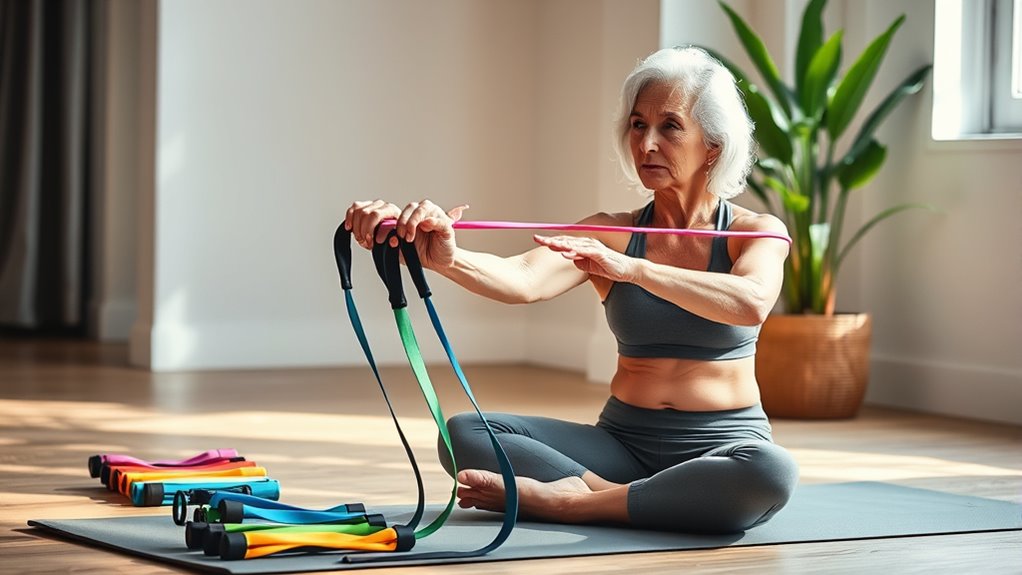
After an injury, getting back to your regular routine can feel challenging, but resistance band exercises offer a gentle way to rebuild strength and mobility. Before starting, consult your healthcare provider to guarantee safety. Focus on controlled movements, and remember to keep the resistance band around your legs or arms as needed. Gradually progressing through these exercises allows you to increase the difficulty at your own pace, reducing the risk of re-injury.
| Exercise | Purpose |
|---|---|
| Seated Leg Press | Strengthen leg muscles |
| Bicep Curls | Build arm strength |
| Lateral Band Walks | Improve hip stability |
| Chest Press | Enhance upper body strength |
Incorporating these bands can greatly aid your recovery!
20-Minute Resistance Band Workout Overview
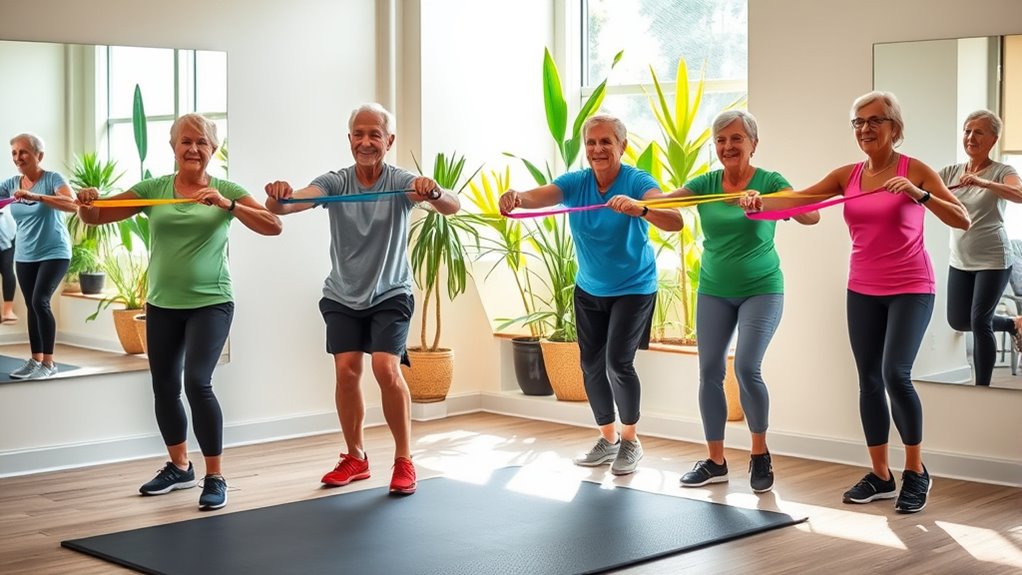
As you recover from your injury, incorporating a minute resistance band workout can be a great way to maintain your strength and mobility.
These workouts focus on low-impact exercises that keep you safe while enhancing your fitness. Here’s a quick overview:
These low-impact workouts prioritize your safety while effectively boosting your fitness levels.
- Warm-up: Begin with gentle stretches to prepare your muscles.
- Upper Body: Use resistance bands with your arms extended to perform shoulder presses at shoulder height, targeting your arms and shoulders.
- Lower Body: Incorporate leg extensions to strengthen your legs without straining.
- Core: Finish with seated twists using resistance bands to engage your core.
You’ll find that a minute workout can be both effective and accessible, helping you stay active while minimizing the risk of injury.
Alternative 20-Minute Resistance Band Workout
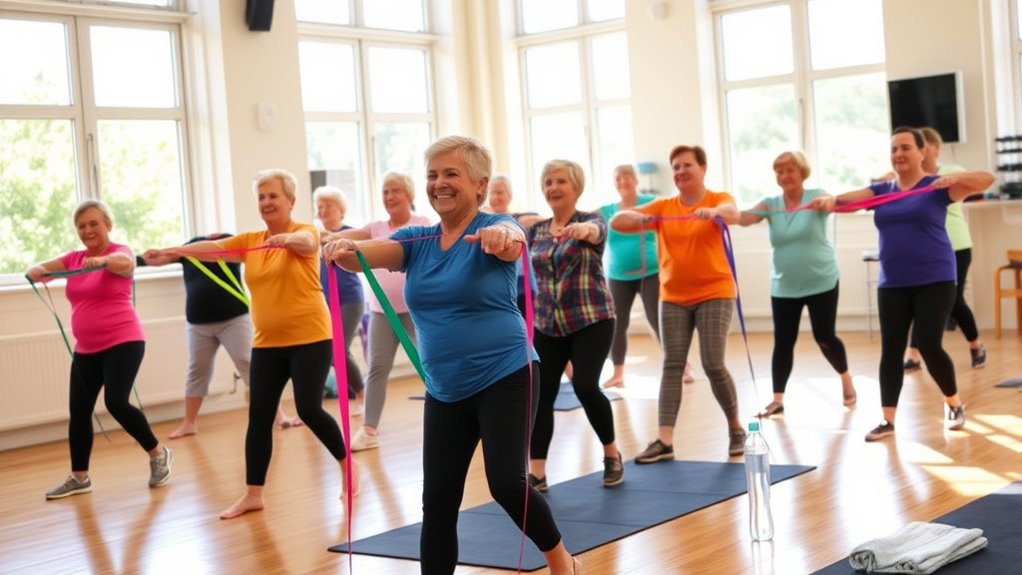
If you’re looking for a fresh approach to your fitness routine, this alternative 20-minute resistance band workout offers a variety of exercises that target different muscle groups effectively.
Start by using resistance bands to perform leg presses, ensuring your feet are hip-width apart for stability.
Next, try seated abductions by sitting on a chair, holding the band around your thighs, and pushing against it to activate your hip muscles.
Finally, incorporate bicep curls while standing, holding the band with both hands, and pulling it up towards your shoulders.
This routine emphasizes gradual progression and safety, allowing you to enhance your strength and mobility without risking injury.
Plus, it’s easily done at home, making fitness accessible and enjoyable!
Benefits of LIT Axis Resistance Bands for Seniors

LIT Axis Resistance Bands offer seniors a modern and effective way to enhance their fitness journey.
These innovative bands provide several benefits that make exercising accessible and enjoyable:
- Real-time Tracking: Built-in sensors connect to the LIT app, allowing you to monitor your movements and progress effectively.
- Personalized Plans: Access certified fitness trainers for tailored workouts that suit your unique needs and goals.
- Gradual Progression: The technology supports safe strength training progression, helping you build resistance at your own pace.
- Portability: Lightweight and easy to carry, these bands allow you to maintain your movement routines at home or on the go.
With LIT Axis, you can embrace resistance training and improve your overall well-being confidently.
Continued Learning and Resources
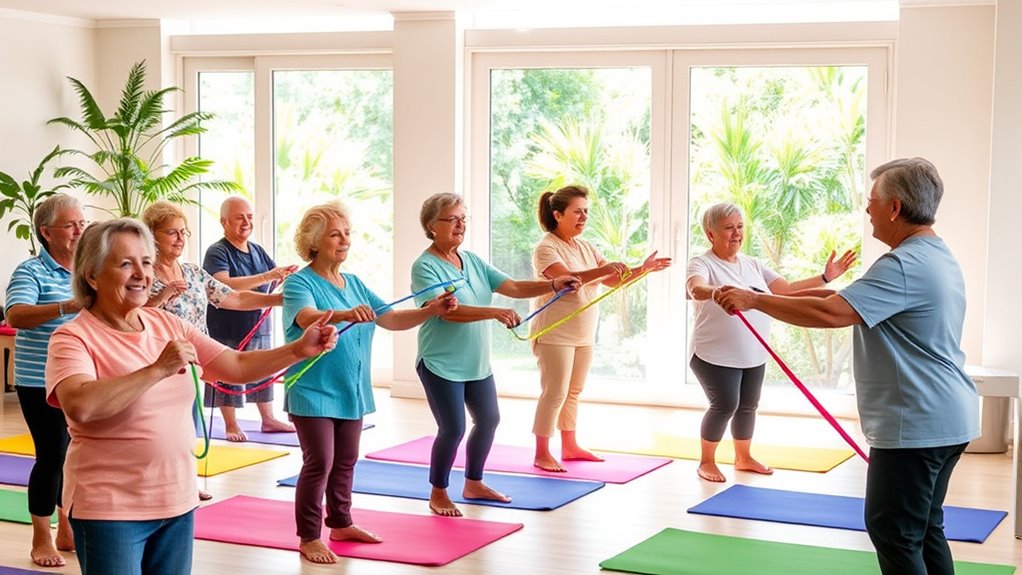
How can you keep your fitness journey exciting and effective as you incorporate resistance band workouts?
Start by tapping into continued learning resources. Subscribe to newsletters that offer updates on different exercises, special offers, and fitness tips specifically for seniors.
Video demonstrations can greatly enhance your understanding, helping you execute resistance band exercises correctly.
Joining online communities lets you share experiences and find motivation from others on similar fitness paths.
If you seek personalized guidance, consider fitness apps that connect you with certified trainers who can design tailored workout plans.
Regularly exploring new exercises and variations keeps your routine fresh, challenging your strength and flexibility while maintaining your interest in resistance band training.
Frequently Asked Questions
Is Resistance Band Training Good for Seniors?
Yes, resistance band training is great for you as a senior.
It helps maintain and improve your muscle strength and flexibility, which is essential for daily activities. You can easily adjust the resistance levels, allowing you to progress safely without the risk of injury.
Can You Build Strength With Just Resistance Bands?
Absolutely, you can build strength using just resistance bands!
They offer adjustable resistance that lets you target different muscle groups effectively. You’ll find that these bands engage your muscles throughout their full range of motion, enhancing both strength and endurance.
Plus, they’re versatile enough to provide an extensive workout, whether you’re focusing on your upper or lower body.
How to Get Rid of Flabby Arms With Resistance Bands?
To get rid of flabby arms with resistance bands, start incorporating exercises like bicep curls and tricep extensions into your routine.
Aim for 2 to 3 sessions per week, doing 8-12 repetitions per exercise. Adjust the band’s resistance as you gain strength, challenging your muscles effectively.
Consistency is key, so stick with it!
Pair your workouts with a balanced diet for the best results and to enhance overall muscle definition.
How Many Pounds of Resistance Band for Beginners?
Imagine lifting a feather versus a rock; that’s the difference in resistance bands for beginners.
You should start with bands that offer 5 to 10 pounds of resistance. This range keeps your movements controlled and helps you maintain proper form—crucial for avoiding injury. As you build strength, gradually increase the resistance.
Choosing lighter colors usually indicates lower resistance, making it easier for you to pick the right band for your workouts.
Conclusion
Incorporating resistance band workouts into your routine can transform your strength journey in ways you never expected. As you explore the exercises, you may find yourself gaining confidence and energy, leading to a more active lifestyle. But what if you could release even more potential with just a few simple adjustments? Don’t stop here—continue to challenge yourself and discover the incredible benefits waiting for you. Your next fitness breakthrough might be just a band away!




